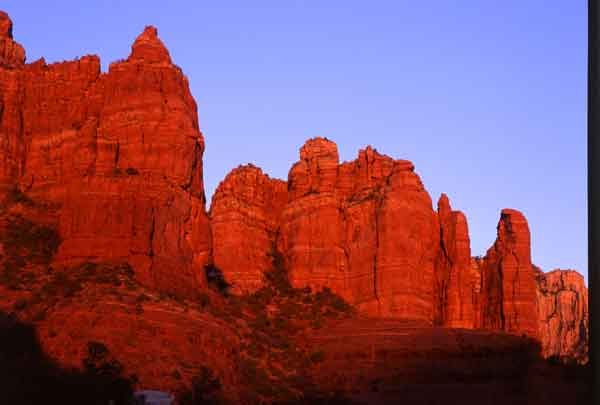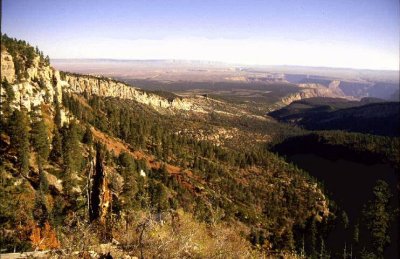Short Takes
Farewell, Our Western Deserts Friend

Jay Krienitz is off to Thailand and Southeast Asia.
Photo by Jason Williams.
This month, AWC staff and wilderness friends around the state bid adieu
to our Western Deserts Regional Coordinator, Jay Krienitz, who has worked
tirelessly to forge meaningful allies for wilderness protection in his
region. Armed with a dash of charm, an illuminating wilderness presentation,
and a positive attitude, Jay set off this fall to open doors in the
Western Deserts region—known as a popular stomping grounds for off-road
vehicle clubs—to the concept of wilderness protection and the work of
the Arizona Wilderness Coalition.
“I believe that there is a common appreciation of Arizona’s wild places,
regardless of the way we choose to spend our time in them,” says Jay.
“Some like to ride dirt bikes and other off-road vehicles, some like
to horseback, others like to hike, and some like to just drive by on
our Arizona highways and look—but the common bond is that most of us
just like to be out there. The commonality between Arizonans
is our need to preserve our wild places so that we may continue to enjoy
them. Additional wilderness designation on public lands is in the best
interest of our society’s needs and the environment that supports us.
I only hope that my voice in the wilderness was heard.”
In addition to his work for the Coalition, Jay completed his Master’s
in Environmental Studies and Public Land Conservation at Prescott
College, producing a thesis on weather or not “previous Arizona BLM
Wilderness Inventories are complete or adequate for present society’s
social and scientific needs.” Jay will be departing for a much-deserved trip overseas, where he plans
to sightsee in Thailand and Southeast Asia.
Wilderness protection will continue in Jay’s absence—under the leadership
of Prescott College and one of Jay’s closest field colleagues, Jason
Williams. After immersing himself in the wonders of the Far East, Jay
plans to return to Arizona for a short while this spring—picking up
where he left off his Western Deserts work and covering the Central
Mountains-Sonoran region for Jason while he takes a short break.
We will miss Jay’s exuberance, fearlessness, and dedication to wilderness
in a region where subtle beauty speaks volumes.
"Jay is a born organizer – the type of person who calls, just
out of the blue, to see how you're doing," says AWC's Executive
Director Don Hoffman. "As a result, he builds productive relationships
in a way that seems very easy, but it's not. I admire this attribute.
He definitely has a future in this business."
...and a Special Thanks
A special thanks to
Julie Spear, AWC’s Prescott office work study student, who was graduated
from Prescott College in December. Julie brought much needed energy
and support to AWC’s Prescott office and worked overtime in addition
to her academic responsibilities to help out with media and outreach
for the Coalition.
One of Julie’s most critical accomplishments was to approach a multitude
of businesses and organizations in Arizona that would potentially support
wilderness protection and the work of the Coalition. With her help,
AWC added a significant and vital component of wilderness advocates
to the Coalition’s arsenal of allies. Thank you Julie, and good luck
with all your future endeavors!
20 Years and Still Stunning: 2004 Wilderness
Anniversaries

Munds Mountains Wilderness, bathed in a russet
desert glow. Photo by Mark Miller.
2004 marks the 20th anniversary of the 1984 Arizona Wilderness Act,
which set aside gems such as the Superstition Mountains Wilderness,
Red Rock-Secret Mountain Wilderness, Munds Mountain Wilderness, Kanab
Creek Wilderness, Hellsgate, and Escudilla Wilderness areas. Without this landmark legislation,
Arizona would be barren of the natural beauty that marks her as one
of the most popular vacation destinations in the West.
2004
also marks the 40th Anniversary of the 1964 Wilderness Act itself—the
federal legislation that created the National Wilderness Preservation
System and launched the critical process of safeguarding our most precious
and remaining wild lands left in America. The Act was passed "In
order to assure that an increasing population, accompanied by expanding
settlement and growing mechanization, does not occupy and modify, all
areas within the United States..." We don't know about the
rest of you, but in Arizona, we plan to do just that.
Stay
tuned to AWC’s website and alerts for upcoming plans and information
surrounding the Anniversary in September 2004.
Goshawk Gets A Fair Shake
The 9th Circuit Court of Appeals recently ruled in favor of the Center
for Biological Diversity (CBD) and the Sierra Club in their lawsuit
against the U.S. Forest Service for its failure to protect the Northern
goshawk, an imperiled raptor, from the negative effects of continued
logging of old-growth and large trees in National Forests within Arizona
and New Mexico. The unanimous opinion, written by Judge Donald J. Pogue,
agreed with the plaintiffs that the Forest Service had failed to consider
or disclose to the public extensive scientific evidence that the goshawk
prefers old-growth and mature forest for breeding and foraging in its
development of a regional goshawk management plan.
According to Michael Lozeau, an attorney with Earthjustice, the 9th
Circuit Court of Appeals' decision requires the Forest Service to re-write
the 1996 Final Environmental Impact Statement and Record of Decision
for Eleven Forest Plans.
"The Court ruled that the Forest Service violated the National
Environmental Policy Act by omitting important scientific evidence from
its Environmental Impact analysis." said Lozeau. "The Forest
Service omitted information that refutes the agency's contention that
goshawks don't like foraging in old growth forests and that it's okay
to cut them down."

Prescribed burns, not widespread logging, are
good ways to reduce dangerous fuel build-up
in goshawk habitat. Photo: U.S. Forest Service.
This
suit is an important milestone in the effort to protect declining goshawk
populations and the increasingly rare old-growth forests that they depend
upon," stated Brian Segee, Southwest Public Lands Director with
CBD. "This decision provides an opportunity for the Forest Service
to develop new management direction which allows fuel reduction measures
such as prescribed burning and thinning of small-diameter trees to go
forward while ensuring that large trees and mature forests are preserved."
Sierra Club Forest Issues Chair, Sharon Galbreath, agreed that the
decision will promote better forest health management decisions, especially
on the Kaibab National Forest just north of Grand Canyon National Park
where conservationists have challenged old-growth logging. According
to Forest Service data, 87 % of the trees on National Forest Lands in
the Southwest are 12 inches in diameter or smaller. The greatest forest
health and fire risks come from small diameter trees, not from the fire
resistant old growth trees that the Forest Service continues to log
under the guise of providing habitat for the northern goshawk.

A stunning view of the East Rim. Photo: NPS
“In light of the Court's finding, we urge the Forest Service to vacate
their decision
to log 7,400 large diameter old-growth trees in goshawk habitat less
than three miles from the boundary of Grand Canyon National Park,"
said Galbreath, speaking of the East Rim timber sale. "The Forest
Service cannot continue to ignore solid science that says the goshawk
needs old growth and mature forests to survive."
The suit was filed in September 2000 in Federal District Court in Arizona.
After the District Court upheld the Forest Service's failure to disclose
evidence that disagreed with the agency, plaintiffs appealed to the
9th Circuit Court of Appeals.
At stake in the case are 8 million acres of ponderosa pine habitat
in Arizona and New Mexico. The Forest Service goshawk management plan
guiding logging operations in these areas was first implemented in 1992
in response to concerns by environmentalists and researchers that goshawks
were being harmed by the logging of mature and old-growth trees. Though
the plan allowing continued old-growth logging was roundly criticized
for by the U.S. Fish and Wildlife Service and the Department of Interior,
Arizona Game and Fish Department, the New Mexico Department of Game
and Fish, U.S. Forest Service biologists, and academic biologists, it
was formally adopted by the Forest Service as a permanent plan in 1996.
In striking down the plan, the court found that the Forest Service's
analysis "completely failed" to "address or refute"
these many objections.
FOR MORE INFORMATION, PLEASE CHECK:
The
Center for Biological Diversity's website and The Southwest Forest
Alliance site at www.swfa.org.
Businesses Find Wilderness a Boon
The last few months have shown a marked increase in the amount of businesses
and conservation organizations that support the mission and actions
of the Arizona Wilderness Coalition. In August, Kate Mackay and Julie
Spear attended a Conservation Summit in Globe, and subsequent to that
meeting, the following groups that had been in attendance became Wilderness
Supporters of the AWC:
- Audubon Arizona
- Arizona Advocacy Network
- Arizona Audubon Council
- Arizona League of Conservation Voters
- Coalition for Sonoran Desert Protection
- Tucson Audubon Society
Also in August, Jason Williams attended the Outdoor Retailers Trade
Show and spoke with many outdoor businesses about the AWC’s goals. He
received enthusiastic support and was able to secure wilderness support
from the following businesses:
- Chaco, Inc.
- EcoAtlas
- Hooked on the Outdoors Magazine
- Outdoor Industry Women’s Council
- Peloton Productions
- URSACK
The Arizona Wilderness Coalition would like to thank the above businesses
and organizations for their support and encourage our members to support
these groups and businesses that have put their names behind what we
do. In addition, we are always looking to make contacts with other businesses
and organizations that support our goals and would like to make a link
to us on their web page.
If you know of anyone who would like to sign up to be a Wilderness
Supporter, please contact Julie Spear at jspear@azwild.org
or Kate Mackay at kmackay@azwild.org.
Roadlessly Devoted to You: Opposition
Grows to RS 2477
Update by Diana Rhoades, Arizona Wilderness Advocate
A movement is growing to stop the Bush Administration’s attempt to
make it easier to pave our public parks and forests through an ancient
mining law from 1866 called Revised Statute 2477.
Locally, Arizonans and other westerners have taken action and made
a difference on the RS 2477 issue. In July, Arizona Democratic Congressman
Raúl Grijalva cosponsored an amendment to the Interior Department’s
spending bill that would have prevented citizen’s tax dollars from being
used to process any illegitimate RS 2477 road proposals. Unfortunately,
the amendment failed on party lines so now National Parks like the Grand
Canyon and National Monuments such as Ironwood remain threatened by
road development.
Sportsmen organizations like Trout Unlimited, Izaak Walton League,
National Wildlife Federation and the Wildlife Management Institute weighed
in on the national effort to protect prime hunting and fishing grounds
from illegitimate RS 2477 road proposals. AJ Chamberlin, a real estate
agent from Boulder, CO, is forming a new national property rights group
to reach out to Arizonans and others across the country to help homeowners
who bought property near public land and then realized there was an
old RS 2477 claim on or near their home. The group, Property Owners
for Sensible Roads Policy, is advocating for federal legislation to
resolve issues on public and private land.
In response to the growing concerns, Colorado Congressman Mark Udall
sponsored legislation to address real road claims and iron out the legalities
of the Administration’s attack on public lands through RS 2477. Rep.
Grijalva is the only Arizona co-sponsor of that legislation, HR 1639.
Please contact your local Congressman and elected officials to ask for
their support of HR 1639. For more information about the threats to
public land from RS 2477, please visit www.highway-robbery.org/.
|

